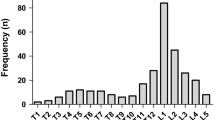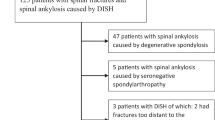Abstract
The intraosseous fluid sign (IFS) in chronic osteoporotic vertebral fractures is attributed to fluid accumulation within non-healing intervertebral clefts. IFS can also be seen in acute traumatic fractures, not previously described. We hypothesize a pathophysiological mechanism for the acute traumatic intraosseous fluid sign (ATIFS) and its predisposition to dynamic fracture mobility with axial loading on upright radiographs. Retrospective analysis was performed of 41 acute thoracic and lumbar compression or stable burst fractures with both supine CT and upright plain films completed within 1 week of each other. The presence of an intravertebral cleft with fluid attenuation and vertebral body height loss was assessed on CT scans. Changes in the fractured vertebral body height and angulation were measured on upright radiographs. The ATIFS was identified in 18 (44%) of the 41 acute fractures. Mean kyphotic angle increase was significantly greater (p = 0.000) for ATIFS fractures (8.2°, SD ±4.2) than fractures without ATIFS (1.6°, SD ±3.4). There was significantly greater mean anterior (p = 0.0009) and central (p = 0.026) height loss in ATIFS fractures (4.3 mm, SD ±3.76 and 1.89 mm, SD ±4.44, respectively) compared to fractures without ATIFS (0.59 mm, SD ±2.24 and −0.52 mm, SD ±2.01, respectively). The IFS can be seen in acute traumatic vertebral fractures and show dynamic mobility. These ATIFS fractures show statistically significant greater mean height loss ratio differences and have significantly greater changes in kyphotic angulation on upright imaging when compared to fractures without ATIFS.



Similar content being viewed by others

References
Baur A, Stabler A, Arbogast S, Duerr HR, Bartl R, Reiser M (2002) Acute osteoporotic and neoplastic vertebral compression fractures: fluid sign at MR imaging. Radiology 225(3):730–735. doi:10.1148/radiol.2253011413
Bhalla S, Reinus WR (1998) The linear intravertebral vacuum: a sign of benign vertebral collapse. AJR Am J Roentgenol 170(6):1563–1569. doi:10.2214/ajr.170.6.9609175
Dupuy DE, Palmer WE, Rosenthal DI (1996) Vertebral fluid collection associated with vertebral collapse. AJR Am J Roentgenol 167(6):1535–1538. doi:10.2214/ajr.167.6.8956592
Malghem J, Maldague B, Labaisse MA, Dooms G, Duprez T, Devogelaer JP, Vande Berg B (1993) Intravertebral vacuum cleft: changes in content after supine positioning. Radiology 187(2):483–487. doi:10.1148/radiology.187.2.8475295
Mirovsky Y, Anekstein Y, Shalmon E, Peer A (2005) Vacuum clefts of the vertebral bodies. AJNR Am J Neuroradiol 26(7):1634–1640
Sarli M, Perez Manghi FC, Gallo R, Zanchetta JR (2005) The vacuum cleft sign: an uncommon radiological sign. Osteoporosis international: a journal established as result of cooperation between the European Foundation for Osteoporosis and the National Osteoporosis Foundation of the USA 16(10):1210–1214. doi:10.1007/s00198-005-1833-4
Yu CW, Hsu CY, Shih TT, Chen BB, Fu CJ (2007) Vertebral osteonecrosis: MR imaging findings and related changes on adjacent levels. AJNR Am J Neuroradiol 28(1):42–47
Kawaguchi S, Horigome K, Yajima H, Oda T, Kii Y, Ida K, Yoshimoto M, Iba K, Takebayashi T, Yamashita T (2010) Symptomatic relevance of intravertebral cleft in patients with osteoporotic vertebral fracture. J Neurosurg Spine 13(2):267–275. doi:10.3171/2010.3.SPINE09364
Linn J, Birkenmaier C, Hoffmann RT, Reiser M, Baur-Melnyk A (2009) The intravertebral cleft in acute osteoporotic fractures: fluid in magnetic resonance imaging-vacuum in computed tomography? Spine 34(2):E88–E93. doi:10.1097/BRS.0b013e318193ca06
Jang JS, Kim DY, Lee SH (2003) Efficacy of percutaneous vertebroplasty in the treatment of intravertebral pseudarthrosis associated with noninfected avascular necrosis of the vertebral body. Spine 28(14):1588–1592
McKiernan F, Faciszewski T (2003) Intravertebral clefts in osteoporotic vertebral compression fractures. Arthritis Rheum 48(5):1414–1419. doi:10.1002/art.10984
Alexandru D, So W (2012) Evaluation and management of vertebral compression fractures. Permanente J 16(4):46–51
Denis F (1983) The three column spine and its significance in the classification of acute thoracolumbar spinal injuries. Spine 8(8):817–831
Wood KB, Li W, Lebl DS, Ploumis A (2014) Management of thoracolumbar spine fractures. Spine J: Off J North Am Spine Soc 14(1):145–164. doi:10.1016/j.spinee.2012.10.041
Ghobrial GM, Jallo J (2013) Thoracolumbar spine trauma: review of the evidence. J Neurosurg Sci 57(2):115–122
Wiggins MC, Sehizadeh M, Pilgram TK, Gilula LA (2007) Importance of intravertebral fracture clefts in vertebroplasty outcome. AJR Am J Roentgenol 188(3):634–640. doi:10.2214/AJR.06.0542
Pickhardt PJ, Pooler BD, Lauder T, del Rio AM, Bruce RJ, Binkley N (2013) Opportunistic screening for osteoporosis using abdominal computed tomography scans obtained for other indications. Ann Intern Med 158(8):588–595. doi:10.7326/0003-4819-158-8-201304160-00003
Schreiber JJ, Anderson PA, Rosas HG, Buchholz AL, Au AG (2011) Hounsfield units for assessing bone mineral density and strength: a tool for osteoporosis management. J Bone Joint Surg Am 93(11):1057–1063. doi:10.2106/JBJS.J.00160
Schreiber JJ, Anderson PA, Hsu WK (2014) Use of computed tomography for assessing bone mineral density. Neurosurg Focus 37(1):E4. doi:10.3171/2014.5.FOCUS1483
Teng MM, Wei CJ, Wei LC, Luo CB, Lirng JF, Chang FC, Liu CL, Chang CY (2003) Kyphosis correction and height restoration effects of percutaneous vertebroplasty. AJNR Am J Neuroradiol 24(9):1893–1900
Alanay A, Pekmezci M, Karaeminogullari O, Acaroglu E, Yazici M, Cil A, Pijnenburg B, Genc Y, Oner FC (2007) Radiographic measurement of the sagittal plane deformity in patients with osteoporotic spinal fractures evaluation of intrinsic error. Eur Spine J: Off Publ Eur Spine Soc Eur Spinal Deformity Soc Eur Section Cervical Spine Res Soc 16(12):2126–2132. doi:10.1007/s00586-007-0474-z
Brinckman MA, Chau C, Ross JS (2015) Marrow edema variability in acute spine fractures. Spine J: Off J North Am Spine Soc 15(3):454–460. doi:10.1016/j.spinee.2014.09.032
Wood K, Buttermann G, Mehbod A, Garvey T, Jhanjee R, Sechriest V (2003) Operative compared with nonoperative treatment of a thoracolumbar burst fracture without neurological deficit. A prospective, randomized study. J Bone Joint Surg Am 85-A(5):773–781
Mehta JS, Reed MR, McVie JL, Sanderson PL (2004) Weight-bearing radiographs in thoracolumbar fractures: do they influence management? Spine 29(5):564–567
Auerbach JD, Namdari S, Milby AH, White AP, Reddy SC, Lonner BS, Balderston RA (2008) The parallax effect in the evaluation of range of motion in lumbar total disc replacement. SAS J 2(4):184–188. doi:10.1016/SASJ-2008-0020-RR
Baker LL, Goodman SB, Perkash I, Lane B, Enzmann DR (1990) Benign versus pathologic compression fractures of vertebral bodies: assessment with conventional spin-echo, chemical-shift, and STIR MR imaging. Radiology 174(2):495–502. doi:10.1148/radiology.174.2.2296658
Voormolen MH, van Rooij WJ, van der Graaf Y, Lohle PN, Lampmann LE, Juttmann JR, Sluzewski M (2006) Bone marrow edema in osteoporotic vertebral compression fractures after percutaneous vertebroplasty and relation with clinical outcome. AJNR Am J Neuroradiol 27(5):983–988
Winklhofer S, Thekkumthala-Sommer M, Schmidt D, Rufibach K, Werner CM, Wanner GA, Alkadhi H, Hodler J, Andreisek G (2013) Magnetic resonance imaging frequently changes classification of acute traumatic thoracolumbar spine injuries. Skelet Radiol 42(6):779–786. doi:10.1007/s00256-012-1551-x
Lensing FD, Bisson EF, Wiggins RH 3rd, Shah LM (2014) Reliability of the STIR sequence for acute type II odontoid fractures. AJNR Am J Neuroradiol 35(8):1642–1646. doi:10.3174/ajnr.A3962
Author information
Authors and Affiliations
Corresponding author
Ethics declarations
Conflict of interest
The authors declare that they have no conflict of interest.
Rights and permissions
About this article
Cite this article
Hutchins, T.A., Wiggins, R.H., Stein, J.M. et al. Acute traumatic intraosseous fluid sign predisposes to dynamic fracture mobility. Emerg Radiol 24, 149–155 (2017). https://doi.org/10.1007/s10140-016-1460-8
Received:
Accepted:
Published:
Issue Date:
DOI: https://doi.org/10.1007/s10140-016-1460-8



